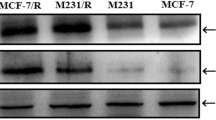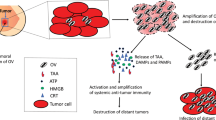Abstract
Paclitaxel (Taxol) is a promising frontline chemotherapeutic agent for the treatment of human breast and ovarian cancers. The adenoviral type 5 E1A gene has been tested in multiple clinical trials for its anticancer activity. E1A has also been shown to sensitize paclitaxel-induced killing in E1A-expressing cells. Here, we show that E1A can sensitize paclitaxel-induced apoptosis in breast cancer cells in a gene therapy setting by an orthotopic mammary tumor model. We first showed that expression of E1A enhanced in vitro paclitaxel cytotoxicity, as compared to the control cells. We then compared the therapeutic efficacy of paclitaxel between orthotopic tumor models established with vector-transfected MDA-MB-231 (231-Vect) versus 231-E1A stable cells, using tumor weight and apoptotic index (TUNEL assay) as the parameters. We found paclitaxel was more effective in shrinking tumors and inducing apoptosis in tumor models established with stable 231-E1A cells than the control 231-Vect cells. We also tested whether E1A could directly enhance paclitaxel-induced killing in nude mice, by using a nonviral, surface-protected cationic liposome to deliver E1A gene via the mouse tail vein. We compared the therapeutic effects of E1A gene therapy with or without Taxol chemotherapy in the established orthotopic tumor model of animals inoculated with MDA-MB-231 cells, and found that a combination of systemic E1A gene therapy and paclitaxel chemotherapy significantly enhanced the therapeutic efficacy and dramatically repressed tumor growth (P<.01). In addition, survival rates were significantly higher in animals treated with combination therapy than in the therapeutic control groups (both P<.0001). Thus, the E1A gene therapy indeed enhances the sensitivity of tumor cells to chemotherapy in a gene therapy setting and, the current study provides preclinical data to support combination therapy between E1A gene and chemotherapy for future clinical trials.
This is a preview of subscription content, access via your institution
Access options
Subscribe to this journal
Receive 12 print issues and online access
$259.00 per year
only $21.58 per issue
Buy this article
- Purchase on Springer Link
- Instant access to full article PDF
Prices may be subject to local taxes which are calculated during checkout





Similar content being viewed by others
References
Hayes DF, Thor AD . c-erbB-2 in breast cancer: development of a clinically useful marker. Semin Oncol. 2002;29:231–245.
Slamon DJ, Leyland-Jones B, Shak S, et al. Use of chemotherapy plus a monoclonal antibody against HER2 for metastatic breast cancer that overexpresses HER2. N Engl J Med. 2001;344:783–792.
Smith IE . New drugs for breast cancer. Lancet. 2002;360:790–792.
Yu DH, Hung MC . The erbB2 gene as a cancer therapeutic target, the tumor-, metastasis-suppressing function of E1A. Cancer Metast Rev. 1998;17:195–202.
Yan D, Shao RP, Hung MC . E1A cancer gene therapy. In: Lattime EC, Gerson SL, eds. Gene Therapy of Cancer. 2nd edn. San Diego, CA: Academic Press; 2002: 465–477.
Pozzatti R, McCormick M, Thompson MA, Khoury G . The E1a gene of adenovirus type 2 reduces the metastastic potential of ras-transformed rat embryo cells. Mol Cell Biol. 1988;8:2984–2988.
Steeg P, Bevilacqua G, Pozzatti R, Liotta LA, Sobel ME . Altered expression of NM23, a gene associated with low tumor metastatic potential, during adenovirus 2 E1a inhibition of experimental metastasis. Cancer Res. 1988;48:6550–6554.
Pozzatti R, McCormick M, Thompson MA, Garbisa S, Liotta LA, Khoury G . Regulation of the metastatic phenotype by the E1A gene of adenovirus-2. Adv Exp Med. 1988;233:293–301.
Yu D, Hamada J, Zhang H, et al. Mechanisms of c-erbB2/neu oncogene-induced metastasis and repression of metastatic properties by adenovirus 5 E1A gene products. Oncogene. 1992;7:2263–2270.
Frisch SM . Antioncogenic effect of adenovirus E1A in human tumor cells. Proc Natl Acad Sci USA. 1991;88:9077–9081.
Chinnadurai G . Adenovirus E1a as a tumor-suppressor gene. Oncogene. 1992;7:1255–1258.
Frisch SM, Mymryk JS . Adenovirus-5 E1A: paradox and paradigm. Nat Rev Mol Cell Biol. 2002;3:441–452.
Yan D, Rau KM, Hung MC . E1A and p202 as anti-metastasis genes. In: Curiel D, Douglas J eds. Cancer Gene Therapy. 2nd edn. Totowa, NJ: Humana Press; 2004 (in press).
Villaret D, Glisson B, Kenady D, et al. A multicenter phase II study of tgDCC-E1A for the intratumoral treatment of patients with recurrent head and neck squamous cell carcinoma. Head Neck. 2002;24:661–669.
Yoo GH, Hung MC, Lopez-Berestein G, et al. Phase I trial of intratumoral liposome E1A gene therapy in patients with recurrent breast and head and neck cancer. Clin Cancer Res. 2001;7:1237–1245.
Hortobagyi GN, Ueno NT, Xia W, et al. Cationic liposome-mediated E1A gene transfer to human breast and ovarian cancer cells and its biologic effects: a phase I clinical trial. J Clin Oncol. 2001;19:3422–3433.
Lowe SW, Ruley HE, Jacks T, et al. p53-dependent apoptosis modulates the cytotoxicity of anticancer agents. Cell. 1993;74:957–967.
Frisch SM, Dolter KE . Adenovirus E1a-mediated tumor suppression by a c-erbB-2/neu-independent mechanism. Cancer Res. 1995;55:5551–5555.
Sanchez-Prieto R, Vargas JA, Carnero A, Marchetti E, et al. Modulation of cellular chemoresistance in keratinocytes by activation of different oncogenes. Int J Cancer. 1995;60:235–243.
Sanchez-Prieto R, Lleonart M, Ramon y Cajal S . Lack of correlation between p53 protein level and sensitivity of DNA-damaging agents in keratinocytes carrying adenovirus E1a mutants. Oncogene. 1995;11:675–682.
Brader KR, Wolf JK, Hung MC, et al. Adenovirus E1A expression enhances the sensitivity of an ovarian cancer cell line to multiple cytotoxic agents through an apoptotic mechanism. Clin Cancer Res. 1997;3:2017–2024.
Ueno N, Yu D Hung MC . Chemosensitization of Her-2/neu-overexpressing human breast cancer cells to paclitaxel (Taxol) by adenovirus type 5 E1A. Oncogene. 1997;15:953–960.
Ueno NT, Bartholomeusz C, Herrmann JL, et al. E1A-mediated paclitaxel sensitization in Her-2/neu-overexpressing ovarian cancer SKOV3.ip1 through apoptosis involving the caspase-3 pathway. Clin Cancer Res. 2000;6:250–259.
Zhou Z, Jia SF, Hung MC, et al. E1A sensitizes HER2/neu-overexpressing Ewing's sarcoma cells to topoisomerase II-targeting anticancer drugs. Cancer Res. 2001;61:3394–3398.
Viniegra JG, Losa JH, Sanchez-Arevalo VJ, et al. Modulation of PI3K/Akt pathway by E1a mediates sensitivity to cisplatin. Oncogene. 2002;21:7131–7136.
Liao Y, Hung MC . Regulation of the activity of p38 mitogen-activated protein kinase by Akt in cancer and adenoviral protein E1A-mediated sensitization to apoptosis. Mol Cell Biol. 2003;23:6836–6848.
Lee W, Tai DI, Tsai SL, et al. Adenovirus type 5 E1A sensitizes hepatocellular carcinoma cells to gemcitabine. Cancer Res. 2003;63:6229–6236.
Zou Y, Peng H, Zhou B, et al. Systemic tumor suppression by the preapoptotic gene bik. Cancer Res. 2002;62:8–12.
Zou Y, Peng H, Zhou B, et al. Correction for Zou et al., Cancer Res. 62(1) 8–12. Cancer Res.. 2002;62:4167.
Li Y, Wen Y, Zhou BP, Kuo HP, Ding Q, Hung MC . Enhancement of Bik antitumor effect by Bik mutants. Cancer Res. 2003;63:7630–7633.
Meric F, Liao Y, Lee WP, et al. Adenovirus 5 early region 1A does not induce expression of the Ewing sarcoma fusion product EWS-FLI1 in breast and ovarian cancer cell lines. Clin Cancer Res. 2000;6:3832–3836.
Nahle Z, Polakoff J, Davuluri RV, et al. Direct coupling of the cell cycle and cell death machinery by E2F. Nat Cell Biol. 2002;4:859–864.
Deng J, Xia W, Hung MC . Adenovirus 5 E1A-mediated tumor suppression associated with E1A-mediated apoptosis in vivo. Oncogene. 1998;17:2167–2175.
Teodoro J, Shore GC, Branton PE . Adenovirus E1A proteins induce apoptosis by both p53-dependent and p53-independent mechanisms. Oncogene. 1995;11:467–474.
McCurrach ME, Connor TMF, Knudson CM, et al. Bax-deficiency promotes drug resistance and oncogenic transformation by attenuating p53-dependent apoptosis. Proc Natl Acad Sci USA. 1997;94:2345–2349.
Fearnhead H, Rodriguez J, Govek EE, et al. Oncogene-dependent apoptosis is mediated by caspase-9. Proc Natl Acad Sci USA. 1998;95:13664–13669.
de Stanchina E, McCurrach ME, Zindy F, et al. E1A signaling to p53 involves the p19(ARF) tumor suppressor. Genes Dev. 1998;12:2434–2442.
Duelli DM, Lazebnik YA . Primary cells suppress oncogene-dependent apoptosis. Nat Cell Biol. 2000;2:859–862.
Putzer BM, Stiewe T, Parssanedjad K, et al. E1A is sufficient by itself to induce apoptosis independent of p53 and other adenoviral gene products. Cell Death Differ. 2000;7:177–188.
Lassus P, Opitz-Araya X, Lazebnik Y . Requirement for caspase-2 in stress-induced apoptosis before mitochondrial permeabilization. Science. 2002;297:1352–1354.
Najafi S, Li Z, Makino K, Shao R, Hung MC . The adenoviral E1A induces p21WAF1/CIP1 expression in cancer cells. Biochem Biophys Res Commun. 2003;305:1099–1104.
Blagosklonny M, Fojo T . Molecular effects of paclitaxol: myths and reality (a critical review). Int J Cancer. 1999;83:151–156.
Yu D, Hung MC . Overexpression of ErbB2 in cancer and ErbB2-targeting strategies. Oncogene. 2000;19:6115–6121.
Yu D, Hung MC . Role of erbB2 in breast cancer chemosensitivity. BioEssays. 2000;22:673–680.
Acknowledgements
This work was supported in part by National Breast Cancer Foundation, Inc., NIH Grant RO1-CA58880, the SPORE grant for ovarian cancer research P50 CA83639 and Cancer Center Supporting Grant CA16772 from the National Institutes of Health (to MCH) and DAMD17-01-1-0300 from the United States Department of Defense Army Breast Cancer Research Program (to YL).
Author information
Authors and Affiliations
Corresponding author
Rights and permissions
About this article
Cite this article
Liao, Y., Zou, YY., Xia, WY. et al. Enhanced paclitaxel cytotoxicity and prolonged animal survival rate by a nonviral-mediated systemic delivery of E1A gene in orthotopic xenograft human breast cancer. Cancer Gene Ther 11, 594–602 (2004). https://doi.org/10.1038/sj.cgt.7700743
Received:
Published:
Issue Date:
DOI: https://doi.org/10.1038/sj.cgt.7700743
Keywords
This article is cited by
-
A novel role mediated by adenoviral E1A in suppressing cancer through modulating decorin
Medical Oncology (2019)
-
The Anti-Tumor Activity of E1A and its Implications in Cancer Therapy
Archivum Immunologiae et Therapiae Experimentalis (2014)
-
An oncolytic adenovirus defective in pRb-binding (dl922–947) can efficiently eliminate pancreatic cancer cells and tumors in vivo in combination with 5-FU or gemcitabine
Cancer Gene Therapy (2011)
-
Intelligent Design: Combination Therapy With Oncolytic Viruses
Molecular Therapy (2010)
-
Adenovirus 5 E1A enhances histone deacetylase inhibitors-induced apoptosis through Egr-1-mediated Bim upregulation
Oncogene (2010)



